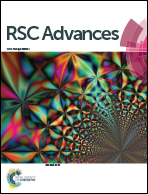Assessment of the effects of nutrients on biomass and lipid accumulation in Dunaliella tertiolecta using a response surface methodology†
Abstract
Bio-energy is arousing the common interest of worldwide researchers to investigate it as a substitute for fossil resources. Compared to other bio-energy sources, algae energy has many advantages. This research was aimed to increase the lipid productivity of Dunaliella tertiolecta, an oleaginous microalgae, by optimizing algal culture medium. Plackett–Burman Design (PBD) was adopted to screen out the critical factors from seven nutritional elements. Box–Behnken design (BBD) was used to seek the optimal nutritional conditions for achieving maximum lipid productivity. Results showed that four nutrients, i.e. NaNO3, NaCl, NaHCO3 and NaH2PO4 2H2O, played a critical role in the accumulation of lipid. GC analysis verified that the four critical nutrients mentioned above had different influences on fatty acid methyl esters, moreover, NaCl had the most prominent effects on fatty acid composition of D. tertiolecta. NaCl 87.69 g L−1, NaNO3 1.77 g L−1, NaH2PO4·2H2O 1.92 g L−1, NaHCO3 5.57 g L−1 were proven to be the optimal culture conditions, under which the lipid productivity in the experiment was 12.576 ± 0.12 mg per L per day, which is approaching the theoretically predicted lipid productivity of 12.925 mg per L per day. The lipid productivity was increased by 31.4% under the optimal culture conditions compared to that under the initial medium composition, indicating that optimization of nutrients could effectively improve the lipid production of D. tertiolecta.


 Please wait while we load your content...
Please wait while we load your content...